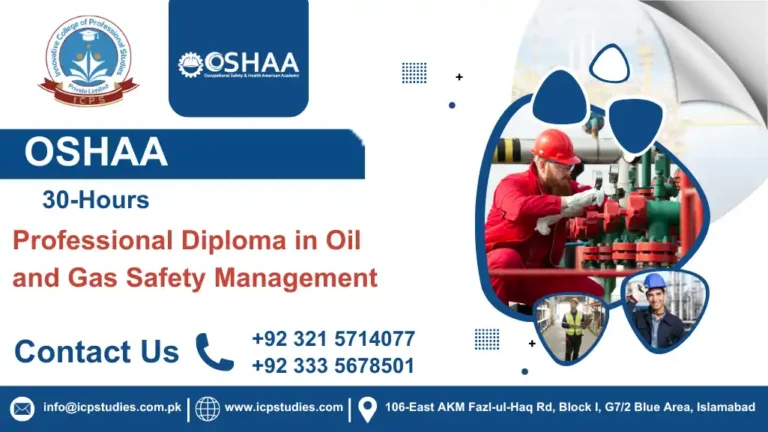The oil and gas industry is known for its complex and high-risk environment. Ensuring the safety and health of workers in this sector is paramount due to the potential hazards such as explosive gases, heavy machinery, and harsh working conditions. The OSHA 10-Hour Oil and Gas Safety and Health course is designed to address these challenges, offering specialized training to help workers navigate and mitigate the unique risks of the oil and gas industry. Here’s a closer look at what this essential course entails and how it can benefit professionals in the field.
The OSHA 10-Hour Oil and Gas Safety and Health course is a focused training program developed by the Occupational Safety and Health Administration (OSHA). It provides an introduction to safety and health regulations and practices specific to the oil and gas industry. This course is intended to equip workers with the knowledge and skills needed to identify and address common hazards encountered in oil and gas operations, helping to create a safer work environment.
The OSHA 10-Hour Oil and Gas Safety and Health course is a critical training program for anyone involved in the oil and gas industry. By providing industry-specific safety knowledge and practical skills, the course helps workers and supervisors navigate the unique challenges of their environment, enhance safety practices, and comply with OSHA regulations. Whether you are a new employee or a seasoned professional, this course offers valuable insights and certification to contribute to a safer and more efficient workplace.
All About OSHA 10-Hour Oil and Gas Safety and Health
Course Overview
The OSHA 10-Hour Oil and Gas Safety and Health course is a specialized training program designed by the Occupational Safety and Health Administration (OSHA) to address the unique safety and health challenges encountered in the oil and gas industry. This course provides essential knowledge and practical skills for workers and supervisors to recognize, assess, and mitigate hazards specific to this high-risk sector.
The OSHA 10-Hour Oil and Gas Safety and Health course is a vital training program tailored to the specific needs of the oil and gas industry. It provides workers and supervisors with the knowledge and skills necessary to navigate the sector’s unique safety challenges, promote a culture of safety, and comply with OSHA regulations. Whether delivered in-person, online, or through a blended format, this course is an essential component for ensuring safety and health in oil and gas operations.
Study Units
- Introduction to OSHA and the Oil and Gas Industry
- Fall Protection
- Electrical Safety
- Confined Space Entry
- Emergency Action Plans
- Fire and Explosion Hazards
- Personal Protective Equipment (PPE)
- Health Hazards in the Oil and Gas Industry
- Hazard Communication and Chemical Safety
- Control of Hazardous Energy (Lockout/Tagout)
To enroll in the OSHA 10-Hour Oil and Gas Safety and Health course, participants typically need to meet the following requirements:
- Age Requirement: Participants should be at least 18 years old.
- Basic Literacy: A good understanding of English is essential, as course materials and instruction are primarily in English.
- Job Relevance: While not mandatory, it is beneficial for participants to be involved in the oil and gas industry or related fields.
- No Formal Prerequisites: There are generally no strict prerequisites for this course, although prior knowledge of safety regulations and practices can be advantageous.
- Course Registration: Participants must register for the course through an authorized training provider.
- Payment: Course fees must be paid as required by the training provider.
- Commitment to Attend: Participants should be prepared to attend the full duration of the course (10 hours) to receive certification.
The OSHA 10-Hour Oil and Gas Safety and Health course is designed for:
- Oil and Gas Workers: Employees in the oil and gas industry seeking foundational safety training.
- Supervisors and Foremen: Individuals overseeing teams in oil and gas operations who need to understand safety protocols.
- New Employees: Those entering the oil and gas sector who require basic safety awareness.
- Safety Coordinators: Professionals responsible for implementing safety measures in oil and gas operations.
- Contractors and Subcontractors: Workers involved in various roles within the oil and gas industry.
- Health and Safety Committee Members: Employees engaged in promoting safety initiatives in their organizations.
This course provides participants with essential knowledge about hazards, safety practices, and regulations specific to the oil and gas industry, helping to create a safer work environment.
4o mini
Learning Outcome
The OSHA 10-Hour Oil and Gas Safety and Health course is structured around several critical study units. Each unit is designed to equip participants with specific knowledge and skills necessary for maintaining a safe work environment in the oil and gas industry. Here are the learning outcomes for each study unit:
1. Introduction to OSHA and the Oil and Gas Industry
- Understanding OSHA’s Role: Participants will learn about OSHA’s regulations and enforcement policies, specifically as they apply to the oil and gas industry.
- Industry Overview: Gain an understanding of the unique safety challenges and regulatory requirements associated with the oil and gas sector.
- Safety Culture: Recognize the importance of a proactive safety culture and how OSHA’s guidelines help foster it.
2. Fall Protection
- Identifying Fall Hazards: Participants will be able to identify common fall hazards present in oil and gas operations, such as elevated work areas and open pits.
- Fall Protection Systems: Learn about various fall protection systems, including harnesses, guardrails, and safety nets, and their proper use.
- Implementation and Compliance: Understand the requirements for implementing fall protection measures and ensuring compliance with OSHA standards.
3. Electrical Safety
- Recognizing Electrical Hazards: Identify potential electrical hazards in oil and gas operations, such as exposed wiring and faulty equipment.
- Safe Work Practices: Learn safe work practices to prevent electrical accidents, including proper grounding and the use of insulated tools.
- Emergency Procedures: Understand emergency procedures for dealing with electrical shocks and fires.
4. Confined Space Entry
- Hazards of Confined Spaces: Understand the specific hazards associated with confined spaces in the oil and gas industry, such as toxic gases and limited access.
- Entry Procedures: Learn the proper procedures for entering confined spaces, including the use of permits and monitoring equipment.
- Emergency Response: Gain knowledge on how to respond to emergencies within confined spaces, including rescue procedures and first aid.
5. Emergency Action Plans
- Developing Plans: Learn how to develop and implement effective emergency action plans tailored to oil and gas operations.
- Roles and Responsibilities: Understand the roles and responsibilities of employees during emergencies, including evacuation procedures and communication protocols.
- Drills and Training: Recognize the importance of regular drills and training to ensure preparedness for emergency situations.
6. Fire and Explosion Hazards
- Identifying Hazards: Identify common fire and explosion hazards in the oil and gas industry, such as flammable materials and high-pressure equipment.
- Preventive Measures: Learn preventive measures to minimize fire and explosion risks, including proper storage of flammable materials and maintenance of equipment.
- Emergency Response: Understand fire and explosion response procedures, including the use of fire extinguishers and emergency evacuation protocols.
7. Personal Protective Equipment (PPE)
- Selecting PPE: Learn how to select appropriate personal protective equipment based on the specific hazards present in the oil and gas industry.
- Proper Use: Understand the correct use and maintenance of PPE, including helmets, gloves, and respirators.
- Training and Compliance: Recognize the importance of PPE training and ensure compliance with OSHA regulations regarding its use.
8. Health Hazards in the Oil and Gas Industry
- Identifying Health Hazards: Identify common health hazards, such as exposure to hazardous chemicals and extreme temperatures, encountered in oil and gas operations.
- Preventive Measures: Learn preventive measures and controls to mitigate health risks, including hygiene practices and proper ventilation.
- Health Monitoring: Understand the importance of health monitoring and medical evaluations for workers exposed to health hazards.
9. Hazard Communication and Chemical Safety
- Understanding GHS: Learn about the Globally Harmonized System (GHS) for hazard communication and its implementation in the oil and gas industry.
- Labeling and Safety Data Sheets (SDS): Understand the requirements for labeling hazardous chemicals and maintaining safety data sheets.
- Training Requirements: Recognize the need for proper training on chemical hazards and safety procedures.
10. Control of Hazardous Energy (Lockout/Tagout)
- Lockout/Tagout Procedures: Learn the procedures for controlling hazardous energy during maintenance and servicing of equipment.
- Identifying Energy Sources: Understand how to identify and isolate energy sources, such as electrical, mechanical, and hydraulic systems.
- Compliance and Enforcement: Ensure compliance with OSHA’s lockout/tagout regulations and recognize the importance of enforcement to prevent accidental releases of hazardous energy.
FAQs about OSHA 10-Hour Oil and Gas Safety and Health







